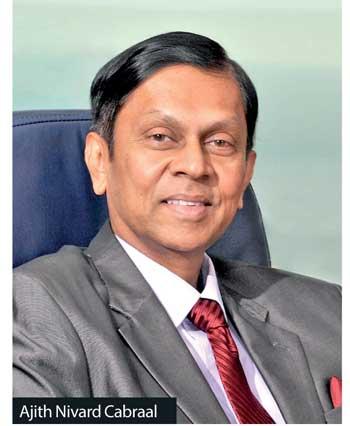15 Oct 2021 - {{hitsCtrl.values.hits}}
The Central Bank yesterday left its key policy rates unchanged indicating that the Monetary Board considers the current monetary policy stance is appropriate to both fend off any demand side inflationary pressures, while supporting the recovery of the economy gradually coming off the month-long virus-related restrictions.
 After cutting rates to their historically low levels since the onset of the pandemic, the Central Bank on August 19 raised policy rates by 50 basis points taking its Standing Deposit Facility Rate and the Standing Lending Facility Rate to 5.0 percent and 6.0 percent respectively as it clawed back some amount of pandemic era stimulus, while keeping a bulk of the support required for an economic rebound.
After cutting rates to their historically low levels since the onset of the pandemic, the Central Bank on August 19 raised policy rates by 50 basis points taking its Standing Deposit Facility Rate and the Standing Lending Facility Rate to 5.0 percent and 6.0 percent respectively as it clawed back some amount of pandemic era stimulus, while keeping a bulk of the support required for an economic rebound.
While there were expectations by certain quarters for the Central Bank to deliver another rate hike at this week’s policy meeting given some sharp increases in the government securities yields in the run-up to Wednesday’s policy meeting, the Central Bank shrugged it off saying some of it was “excessive”, though they broadly reflected, a“market correction”.
At the primary bill auction held this Wednesday, the yield of the 3-month bill jumped 89 basis points to 8.04 percent, taking the total increase in the shortest tenor bill to 196 basis points since yield caps on bills were taken out.
While bids received for the one-year bills were outright rejected at this week’s auction due to the excessively higher bids received, the yield of the benchmark yield has risen by 116 basis points since yield caps were removed in mid-September.
At the monetary policy meeting this week, as any other central bank in the world in the current context, Sri Lanka took the view that its actions should neither overheat the economy nor should be overly restrictive of economic growth, which is coming off after being struck down by the repeated virus waves.
Drawing to the still solid growth in private and public sector credit growths through August, Central Bank Governor Ajith Nivard Cabraal said, “We don’t need to dampen that, neither do we want to stimulate it any further,” suggesting the fine line they expect to walk in setting the money policy.
Despite some upward adjustments in market lending and deposit rate in response to the policy rate hike in August, the Central Bank doesn’t think that will have a significant impact on appetite for credit, which will power economic growth in the remainder of the year and beyond into the medium term, although the Monetary Board is willing reassess the pace of growth in credit should there any signs of excesses.
Although there could be some slowdown in growth in the third quarter economic output, the Central Bank continues to maintain its 5.0 percent growth for the full year, pinned on a much higher growth in the first quarter and the low base in 2020. The Sri Lankan economy grew by 8.0 percent in the first half of 2021, partly on lower base effects last year.
This estimate is substantially higher than the 3.6 percent growth re-projected by the International Monetary Fund this week, which was lower than their July forecast of 4.0 percent on persistent pandemic pressures, which threw speed bumps into recovery everywhere in the world.
While shrugging off any demand side pressures on prices triggered by the Central Bank liquidity as claimed by certain sections of the economy, the Central Bank said the current bout of higher prices are predominantly caused by high food prices and some acceleration in non-food prices which are mainly driven by supply side pressures.
The global commodities prices from food and energy to metal to most others have been rising exponentially due to the supply chain bottlenecks caused by the pandemic induced interruptions in main producing regions in Asia, port delays, higher shipping cost and the pent up demand which the supply is unable to keep up with.
Hence the Central Bank said monetary policy cannot tackle such pressures in the supply side and could subside when anomalies created by the pandemic fade and the global demand conditions normalise.
“ While such supply side developments in the near term do not warrant monetary policy tightening, measures already taken by the Central Bank in relation to interest rates and market liquidity would help stabilise demand pressures over the medium term”, the statement issued by the Monetary Board said. However, the Monetary Board said the recent upward price revisions could cause headline inflation to deviate somewhat from its desired levels in the near term, although it ruled out the possibility for a double-digit inflation.
The Central Bank’s desired level of headline inflation is maintained between 4 to 6 percent.
On the external front, Governor Cabraal said their recent measures had eased anxieties and expressed optimism that inflows stipulated in the six-month road map are on course, which would further stabilise the conditions while instilling further confidence on the external sector.
During the last couple of weeks, the Central Bank intervened by directly issuing foreign currency to clear essential imports such as fuel and milk powder, clearing impediments the importers had while restoring the essential food supplies into the markets.
Meanwhile, abandoning of controlled prices by the government is also restoring the local supply chains, which did not function at their optimal levels.
The Central Bank will also maintain the foreign exchange rate at the current level to the dollar, Cabraal added.
24 Nov 2024 3 hours ago
24 Nov 2024 3 hours ago
24 Nov 2024 4 hours ago
24 Nov 2024 9 hours ago
24 Nov 2024 9 hours ago